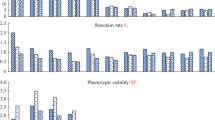Abstract
Results of ten cycles of divergent selection on water extract viscosity (WEV) based on varieties of winter rye Al’fa and Moskovskaya 12 are presented. Efficiency of selection depended both on genotype of a variety and direction of selection. Selection in a plus-direction was more effective than in a minus-direction. After ten cycles of selection, the potential of WEV increased in high viscosity populations by 3.3–6.0 times, while it decreased by 2.6–3.5 times in low viscosity populations. The asymmetry of the response was detected during the first cycle of the selection and it remained in all subsequent cycles. The high viscosity populations were more yielding (by 23.8%) than low viscosity populations and had the best baking qualities of grain. Their superiority manifested the most strongly by grain unit (by 7.9%), weight of 1000 grains (by 23.4%), falling number (by 90 s), amylogram height (by 5.4 times), and gelatinization temperature of starch (by 3.2°С). From low viscosity populations, strongly blurring bread with large pores and sticky and restive crumb was produced. Prospects of selection of baking and fodder varieties of a winter rye based on selection of genotypes with high and low WEV are discussed.
Similar content being viewed by others
References
Kalashnikov, A.P., Fisinin, V.I., Shcheglov, V.V., et al., Normy i ratsiony kormleniya sel’skokhozyaistvennykh zhivotnykh (Standards and Rations of Farm Animals Feeding), Moscow, 2003.
Henry, R.J., A comparison of the non-starch carbohydrates in cereal grains, J. Sci. Food Agric., 1985, vol. 36, no. 12, pp. 1243–1253.
Rakowska, M., The nutritive quality of rye, Vortr. Pflanzenzucht., 1996, vol. 35, pp. 85–95.
Weipert, D., Pentosans as selection traits in rye breeding, Vortr. Pflanzenzucht., 1996, vol. 35, pp. 109–119.
Boros, D. and Bedford, M.R., Influence of water extract viscosity and exogenous enzymes on nutritive value of rye hybrids in broiler diets, J. Anim. Feed Sci., 1999, vol. 8, pp. 579–587.
Madej, L., Raczynska–Bojanowska, K., and Rybka, K., Variability of the content of soluble noningestible polysaccharides in rye inbred lines, Plant Breed., 1990, vol. 104, pp. 334–339.
Bengtsson, S. and Aman, P., Isolation and chemical characterization of water-soluble arabinoxylans in rye grain, Carbohydr. Polym., 1990, vol. 12, no. 3, pp. 267–277.
Boros, D., Marquardt, R.R., Slominski, B.A., and Guenter, W., Extract viscosity as an indirect assay for water-soluble pentosan content in rye, Cereal Chem., 1993, vol. 70, no. 5, pp. 575–580.
Rybka, K., Boros, D., Rachynska–Bojanowska, K., Rakowska, M., Sawicka-Zukowska, R., and Jedrychowska, B., Viscosity of rye grain components, Mol. Nutr. Food Res., 1988, vol. 32, no. 8, pp. 723–804.
Madej, L., Breeding approarch to the improvement of feeding quality of rye grain, Hod. Rosl., Aklimat. Nasienn., 1994, vol. 38, no. 5, pp. 91–94.
Saastomoinen, M., Plaami, S., and Kumpulainen, J., Pentosan and ß-glucan content of Finnisch winter rye varieties as compared with rye of six other countries, J. Cereal Sci., 1989, vol. 10, no. 3, pp. 199–207.
Jurgens, H.-U., Jansen, G., and Wegener, C.B., Characterization of several rye cultivars with respect to arabinoxylans and extract viscosity, J. Agric. Sci., 2012, vol. 4, no. 5, pp. 1–12.
Nilsson, M., Andersson, R., Andersson, R.E., Auotic, K., and Aman, P., Heterogeneity in a water–extractable rye arabinoxylan with a low degree of disubstitution, Carbohydr. Polym., 2000, vol. 41, no. 4, pp. 397–405.
Bengtsson, S., Andersson, R., Westerlund, E., and Aman, P., Content,structure and viscosity of soluble arabinoxylans in rye grain from several countries, J. Sci. Food Agric., 1992, vol. 58, no. 3, pp. 331–337.
Campbell, G.L., Teitge, D.A., and Classen, H.L., Genotypic and environmental differences in rye fed to broiler chicks with dietary pentosanase supplementation, Can. J. Anim. Sci., 1991, vol. 71, pp. 1241–1247.
McLeod, J.G., Gan, Y., Scoles, G.J., and Campbell, G.L., Extract viscosity and feeding quality of rye, Vortr. Pflanzenzucht., 1996, vol. 35, pp. 97–108.
Kucerova, J., Effects of location and year on technological quality and pentosan content in rye, Czech J. Food Sci., 2009, vol. 27, pp. 418–424.
Kolasinska, I., Boros, D., Madej, L., and Cygankiewich, A., Quantitative characteristic of rye inbred lines, Proceeding of the EUCARPIA Rye Meeting, Radzikow, 2001, pp. 315–318.
Cyran, M.R., Ceglinska, A., and Kolasinska, I., Depolymerization degree of water-extractable arabinixylans in rye breed: Characteristics of inbred lines used for breeding of bread cultivars, J. Agric. Food Chem., 2012, vol. 60, no. 35, pp. 8720–8730.
Goncharenko, A.A., Timoshchenko, A.S., Berkutova, N.S., Ermakov, S.A., Makarov, A.V., Semenova, T.V., Tochilin, V.N., Lazareva, E.N., Tsygankova, N.V., and Krakhnalev, S.V., Divergent selection for water-extract viscosity in winter rye, Russ. Agric. Sci., 2011, no. 4, pp. 3–8.
Timoshchenko, A.S., Goncharenko, A.A., and Lazareva, E.N., Adaptation of the rotary viscometer VT5L/R to determination of the relative viscosity of an aqueous extract of the grain meal rye, S-kh. Biol., 2008, no. 5, pp. 110–115.
Goncharenko, A.A., Krakhmalev, S.V., Ermakov, S.A., Makarov, A.V., Semenova, T.V., Tochilin, V.N., and Osipova, A.V., Diallel analysis of grain quality traits in inbred winter rye lines, Russ. Agric. Sci., 2012, no. 6, pp. 14–19.
Kobylyanskii, V.D. and Solodukhina, O.V., Theoretical foundations of forage rye selection for low-water-soluble pentosans, S-kh. Biol., 2013, no. 2, pp. 31–39.
Author information
Authors and Affiliations
Corresponding author
Additional information
Original Russian Text © A.A. Goncharenko, S.A. Ermakov, A.V. Makarov, T.V. Semenova, V.N. Tochilin, A.V. Osipova, E.N. Lazareva, O.A. Krahmaleva, N.A. Jashina, 2016, published in Rossiiskaya Sel’skokhozyaistvennaya Nauka, 2016, No. 4, pp. 3–8.
About this article
Cite this article
Goncharenko, A.A., Ermakov, S.A., Makarov, A.V. et al. Multiple divergent selection on viscosity of a water extract of winter rye. Russ. Agricult. Sci. 42, 289–294 (2016). https://doi.org/10.3103/S1068367416050074
Received:
Published:
Issue Date:
DOI: https://doi.org/10.3103/S1068367416050074




